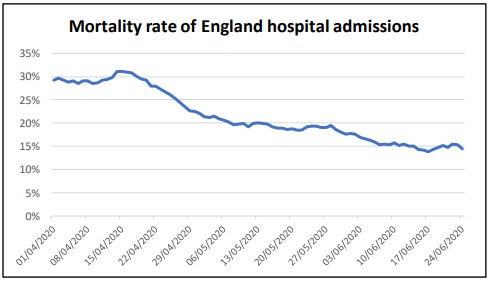Are we getting better at treating Covid19? At least in the UK, yes. Actuaries in the UK (bulletin 50 in the link) have analysed the data there and found a halving of the death rate for those admitted to hospital with Covid19. Their key result is in this graph (1).

They’ve talked to intensive care doctors, and their view is that there are two reasons for this reduction:
- although there were enough staff at all times, at the beginning, many of them had come from other parts of the hospital system, so had to learn routines, and the language of intensive care.
- doctors have learned a lot more about Covid19 and are getting gradually better at treating it. Some examples in the paper:
- effective use of anticoagulants, steroids, and remdesivir (albeit access to this has been limited)
- Much better fluid management, where the traditional pneumonia strategy of conservative fluid management has been relaxed (because with COVID-19, renal
vulnerability has been a new problem). - Better ventilation approaches, where the standard ventilation approach was found to be potentially harmful (owing to the unusual way in which COVID-19 attacks
the lungs, and the vascular damage of the lungs in particular leading to increased thrombosis).
As the authors point out,
The learning, of course, has not been done by doctors in isolation. As more has been learned, more has been communicated, and there are now some excellent resources collating new and better treatment guidance (for instance, BMJ or Brigham as a similar US example).
The combination of many small incremental steps in treatment appears to have halved the death rate from Covid19 for those who are hospitalised (and in a rich country, that is a high share of total patients that might need hospital). While there haven’t been massive individual breakthroughs that make the headlines, the medical profession around the world has shown an amazing ability to share innovation and learn incredibly quickly when faced with this new disease.
Here in Australia, I haven’t been able to find equivalent data, but this article from this week suggests that Australia is already doing even better – with an 85% survival rate from ICU (compared with the UK 85% recent survival rate from all hospital patients).
(1) my initial reaction to this graph was to wonder whether it was just that people were admitted to hospital in a healthier state, now the number of cases have calmed down in the UK. The authors don’t believe this is the case (as hospital admissions have dropped much more than cases) and have a few other pieces of analysis to bolster that view.
Links
This study reported in the British Medical Journal takes the information in the Coronavirus Government Response tracker from Oxford University and compares it by date with the increase in cases in each country to see if it is possible to use the natural experiments around the world to see which aspects of non pharmaceutical interventions are the most effective. The conclusion was not all that surprising – physical distancing interventions are effective!
In this study, five commonly introduced physical distancing interventions in 149 countries were associated with on average a 13% reduction in the incidence of covid-19. No additional benefit was found associated with closures of public transport when a combination of school closures, workplace closures, restrictions on mass gatherings, and restrictions of population movement (ie, lockdown) was in place. A greater reduction in incidence was observed when restriction on mass gatherings was included in the intervention combination, and when lockdown was implemented earlier along with school and workplace closures. The reduction in incidence of covid-19 associated with physical distancing interventions was greater in high income countries (higher GDP per capita), those with an older population (higher proportion of population aged ≥65 years), and those with stronger preparedness for the pandemic (country health security index).
Incidentally, later in the paper I found some evidence that the Australian outcomes are probably owed to luck as well as good management – we were one of the last countries to lock down when the date was compared with the first case discovered:
All the countries included in the analysis (except Belarus and Tanzania) had implemented at least three of the five physical distancing measures by 30 May 2020. All five measures were in place in 118 countries, whereas 25 countries had four policy measures and four countries had three. On average, policies were first implemented 9 days (SD 13 days) after the first reported case. Countries with the longest interval until first implementation of any of the physical distancing policies were Thailand (58 days), Australia (51 days), Canada (46 days), Sri Lanka and the UK (45 days), Finland and Malaysia (42 days), and Cambodia, Sweden, and the US (40 days).
As NSW watches Victoria closely (a colleague estimated NSW is about a month behind Victoria in number of local community transmitted cases) the specific comment in this study that in general, earlier lockdowns are more effective than later lockdowns suggests NSW should be thinking about lockdowns of some kind sooner rather than later.
Life Glimpses
As we in NSW nervously watch a combination of serious lockdowns in Victoria, and increasing community spread of Covid19 in NSW (today there were 13 locally acquired cases in NSW and 62 this week) my little bit of Sydney is still feeling quite relaxed, with queues (without distancing) outside local restaurants and cafés, and very little dodging when it comes to sharing paths.
I’ve bought some masks online, now that they are compulsory in Victoria, as I suspect NSW will move to masks if cases continue to climb, in an effort to avoid full lockdown.
Bit of beauty
This flower is on my favourite Sydney walk – the Spit to Manly walk, which I did with some friends this week. We were all on the look out for some beautiful flowers and we found quite a number, as the Sydney sandstone ecosystem starts flowering ready for spring.


As usual I cannot comment on the serious statistics. Here we have rising number of cases daily and
the instructions are conflicting and based on politics, power play. The population demonstrates as the
number of unemployed is growing. I always go out in a mask and try to keep my distance. Alas not everybody does.
The flower is beautiful – thank you. Keep on finding such flowers.
love
Didn’t realise how long it took us (51 days) to implement SD. We were lucky or some other factor is at play eg strong UV light.
Nice photo. Used to go for walks to Reef Beach from our home in Fairlight in the 50s.
Hi Jennifer, I’m not sure I agree with the authors of the mortality rate study that the bigger fall in hospitalisations compared with case counts provides the evidence needed regarding hospitals admitting cases on the margin. In early April, testing capacity was limited and expanded greatly over the course of April. So I think comparing case counts in early April with case counts in June is not a like-with-like comparison. I’ve done an interesting comparison of the UK case counts with other hard hit countries, and lined them up using the peak in deaths as the alignment point. Shows pretty clearly the impact expanded testing capacity had on the counts. Happy to send it to you if interested. K
I should caveat that to say that I do think there have been improvements in mortality rates, just not a big as what the graph implies
Thanks Karen, I did wonder if it was little bit glib as a comment. That said, it is still very good news to see the improvement there, even if some of it might be due to who is being admitted to hospital. I had been thinking that without a “cure” any improvements in treatment would be too small to measure. I’d be really interested in your model, maybe you could add something to Alex’s weekly updates!
how is the best way to get it to you? I cant find an email address….